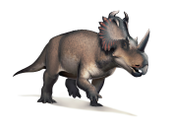孔头龙属
| 孔头龙属 化石时期:晚白垩世,
| |
|---|---|

| |
| Holotype specimen CMN 1423 | |
| 科学分类 | |
| 界: | 动物界 Animalia |
| 门: | 脊索动物门 Chordata |
| 纲: | 蜥形纲 Sauropsida |
| 总目: | 恐龍總目 Dinosauria |
| 目: | †鸟臀目 Ornithischia |
| 科: | †厚头龙科 Pachycephalosauridae |
| 属: | †孔头龙属 Foraminacephale Schott & Evans, 2016 |
| 模式種 | |
| †短体孔头龙 Foraminacephale brevis (Lambe, 1918)
| |
| 異名 | |
孔头龙(学名:Foraminacephale,意为“有孔的头”)是厚头龙科恐龙的一个属,化石发现于加拿大晚白垩世(坎帕阶)的沉积物中。[1]
描述
[编辑]
作为厚头龙科,孔头龙是种颅骨具有增厚圆顶的小型双足植食动物。2016年,格雷戈里·保罗估计其长1.5米(4.9英尺)、重10公斤(22英磅)。[2]孔头龙圆顶表面有许多小孔,而圆顶本身则是由一个额骨部分倾斜的大型“中瓣”及前部一对较小的“侧叶”构成。[3]鳞骨在圆顶底部形成一圈高耸且完全光滑的骨质隆起,此外圆顶底部还排列着六个骨瘤,正下方还有一个额外的“尖角状”骨瘤。这些特征将孔头龙与所有其它厚头龙科区分开来。[1]
与剑角龙、汉苏斯龙和结头龙不同,孔头龙的顶骨(构成圆顶后部)向后下方突出,超过颅骨基部。[3]另有两项特征将孔头龙与圆头龙及倾头龙区分开来:中瓣与侧叶间有明显的沟槽及颞骨开口呈裂缝状。[1]对一件疑似标本(鉴定为短体孔头龙近似种)进行的微型计算机断层扫描,显示厚头龙科很可能存在头部对撞行为。[4]
个体发生学
[编辑]和剑角龙一样,[5]孔头龙各标本分属的年龄阶段之广,使对圆顶个体发育或生长的研究成为可能。对21个孔头龙颅骨上27个不同部位的测量显示,圆顶随年龄增长而成比例增高,但未明显变宽。对标本的组织学研究显示,圆顶孔洞随年龄增加而减少——最小标本的颅骨有1.67%的空腔,最大标本则为0.25%。总体来说,圆顶额骨部分较顶骨部分更为多孔。[1]
圆顶生长序列将孔头龙进一步区别于剑角龙。年轻剑角龙圆顶平坦,但即使是最小的孔头龙标本,顶骨也已有轻微隆起。孔头龙颅顶的上颞孔呈缝状,与剑角龙的圆孔相反,且在个体发育很早期就已闭合,而非像后者那样在动物一生中都或多或少地保持开放。颅骨空腔规模也小于剑角龙,而更类似高顶龙。此外,孔头龙鳞骨及眶后骨变成圆顶一部分的进度也要快得多,圆顶增厚速率较慢,圆顶侧面倾角也小于剑角龙。[1]
发现与命名
[编辑]孔头龙正模标本CMN 1423是一个接近完整的额顶骨圆顶,于1902年在阿尔伯塔省省立恐龙公园收集并于同年报道。[6]发现标本的岩层隶属贝利河群的恐龙公园组。恐龙公园组还发现许多分属于幼体、亚成体及成体的其它颅骨碎片。[1]
尽管同时期的老人组已报道发现大量标本,[7]但仅有一具(编号为TMP 2015.044.0041)可确认属于孔头龙。另一件来自马蹄谷组、曾经归入孔头龙的标本CMN 11316,则被重新鉴定为一只分类不明的小型幼年厚头龙亚科。[1]
CMN 1423由劳伦斯·赖博于1918年首次归入剑角龙新种,[8]此后有很多人争论短体剑角龙("S." brevis)究竟是代表一种完全不同的动物,还是仅代表一种形态——也许是雌性的直立剑角龙。[9][10][11]其后于2000年被罗伯特·沙立文归入倾头龙,[3]并于2010年被朗里奇、桑基和汤克归入圆头龙。[12]2011年,瑞恩·肖特(Ryan Schott)在其理学博士论文中提出新属名孔头龙(Foraminacephale),因此产生新组合短体孔头龙(Foraminacephale brevis)。[13]但在肖特和大卫·埃文斯于2016年将“短体剑角龙”正式更名为短体孔头龙之前,其仍是一个无效的论文名。属名组合拉丁语foramina(“孔”)及cephale(拉丁化希腊语,意为“头部”),指圆顶顶部布满小孔。[1]
分类
[编辑]2016年一项系统发育分析发现孔头龙是厚头龙亚科成员,处在一个比剑角龙更为衍生、比倾头龙更为原始的位置上。恢复出来的分支图共识如下所示:[1]
| 厚头龙亚目 Pachycephalosauria |
| ||||||||||||||||||||||||||||||||||||||||||||||||||||||||||||||||||||||||||||||||||||||||||
该分支图的拓扑并不稳定,可能是由于大多数厚头龙类标本均不完整。[1]
古生态学
[编辑]贝利河群的厚头龙类遗骸尤为丰富,所有已知厚头龙类化石中,有70%出自该区域。由于对厚头龙类个体发育缺乏认知,很多研究者先后将该材料从短体剑角龙这一个物种归入四个不同属。这对晚白垩世食植恐龙的生物多样性具有重要意义。2016年的孔头龙描述从贝利河群鉴别出四个不同的厚头龙类物种:剑角龙、孔头龙、汉苏斯龙与结头龙,尽管归入汉苏斯龙的标本可能代表不只一个物种。[1]
参见
[编辑]参考资料
[编辑]- ^ 1.00 1.01 1.02 1.03 1.04 1.05 1.06 1.07 1.08 1.09 1.10 Schott, R.K.; Evans, D.C. Cranial variation and systematics of Foraminacephale brevis gen. nov. and the diversity of pachycephalosaurid dinosaurs (Ornithischia: Cerapoda) in the Belly River Group of Alberta, Canada.. Zoological Journal of the Linnean Society. 2016. doi:10.1111/zoj.12465.
- ^ Paul, Gregory S. The Princeton Field Guide to Dinosaurs: Second Edition. Princeton, New Jersey: Princeton University Press. 2016: 268. ISBN 978-0-691-16766-4.
- ^ 3.0 3.1 3.2 Sullivan, R.M. Prenocephale edmontonensis (Brown & Schlaikjer) new comb. and P. brevis (Lambe) new comb. (Dinosauria: Ornithischia: Pachycephalosauria) from the Upper Cretaceous of North America. Lucas, S.G.; Heckert, A.B. (编). Dinosaurs of New Mexico. New Mexico Museum of Natural History and Science Bulletin 17. 2000: 177–190.
- ^ Dyer, Aaron D.; LeBlanc, Aaron R.H.; Doschak, Michael R.; Currie, Philip J. Taking a crack at the dome: histopathology of a pachycephalosaurid (Dinosauria: Ornithischia) frontoparietal dome. Biosis: Biological Systems. 2021, 2 (2): 248–270. doi:10.37819/biosis.002.02.0101
 .
.
- ^ Schott, R.K.; Evans, D.C.; Goodwin, M.B.; Horner, J.R.; Brown, C.M.; Longrich, N.R. Cranial Ontogeny in Stegoceras validum (Dinosauria: Pachycephalosauria): A Quantitative Model of Pachycephalosaur Dome Growth and Variation. PLOS ONE. 2011, 6 (6): e21092. Bibcode:2011PLoSO...621092S. PMC 3126802
 . PMID 21738608. doi:10.1371/journal.pone.0021092
. PMID 21738608. doi:10.1371/journal.pone.0021092  .
.
- ^ Lambe, L. M. New genera and species from the Belly River series (Mid-Cretaceous). Contributions to Canadian Paleontology, Geological Survey of Canada. 1902, 3: 25–81.
- ^ Sullivan, R.M. A taxonomic review of the Pachycephalosauridae (Dinosauria: Ornithischia) (PDF). Lucas, S.G.; Sullivan, R.M. (编). Late Cretaceous vertebrates from the Western Interior. New Mexico Museum of Natural History and Science Bulletin 35. 2006: 347–365 [2016-11-26]. (原始内容 (PDF)存档于2007-09-27).
- ^ Lambe, L.M. The Cretaceous genus Stegoceras typifying a new family referred provisionally to the Stegosauria. Proceedings and Transactions of the Royal Society of Canada. Series 3. 1918, 12: 23–36.
- ^ Brown, B.; Schlaikjer, E.M. A study of the troodont dinosaurs with the description of a new genus and four new species. Bulletin of the American Museum of Natural History. 1943, 82: 121–149. hdl:2246/387.
- ^ Sternberg, C.M. Pachycephalosauridae proposed for dome-headed dinosaurs, Stegoceras lambei, n. sp., described. Journal of Paleontology. 1945, 19 (5): 534–538. JSTOR 1299007.
- ^ Chapman, R.E.; Galton, P.M.; Sepkoski, J.J.; Wall, W.P. A morphometric study of the cranium of the pachycephalosaurid dinosaur Stegoceras. Journal of Paleontology. 1981, 55 (3): 608–618. JSTOR 1304275.
- ^ Longrich, N.R.; Sankey, J. & Tanke, D. Texacephale langstoni, a new genus of pachycephalosaurid (Dinosauria: Ornithischia) from the upper Campanian Aguja Formation, southern Texas, USA. Cretaceous Research. 2010, 31 (2): 274–284. Bibcode:2010CrRes..31..274L. doi:10.1016/j.cretres.2009.12.002.
- ^ Schott, R.K. Ontogeny, Diversity, and Systematics of Pachycephalosaur Dinosaurs from the Belly River Group of Alberta (学位论文). Department of Ecology and Evolutionary Biology, University of Toronto: 173. 2011.



